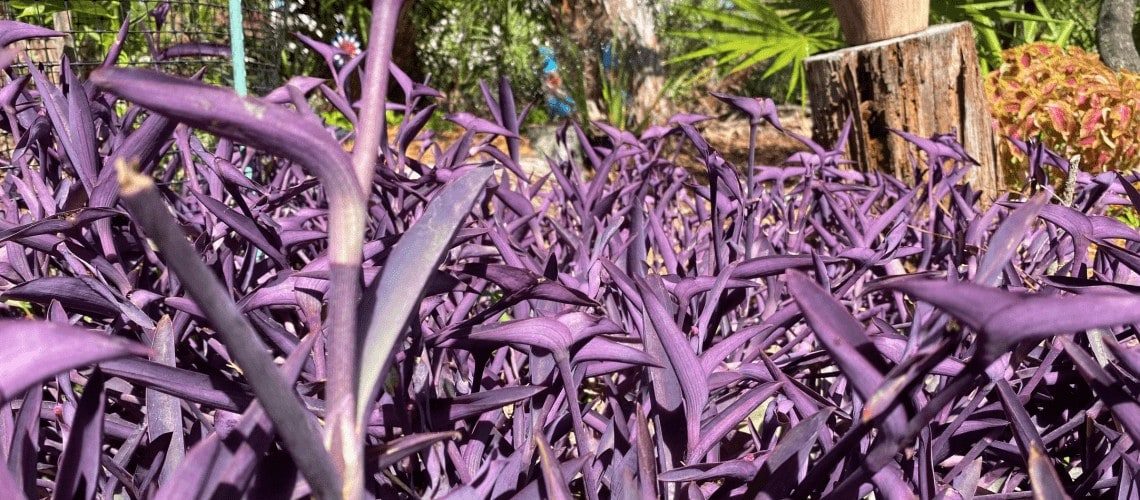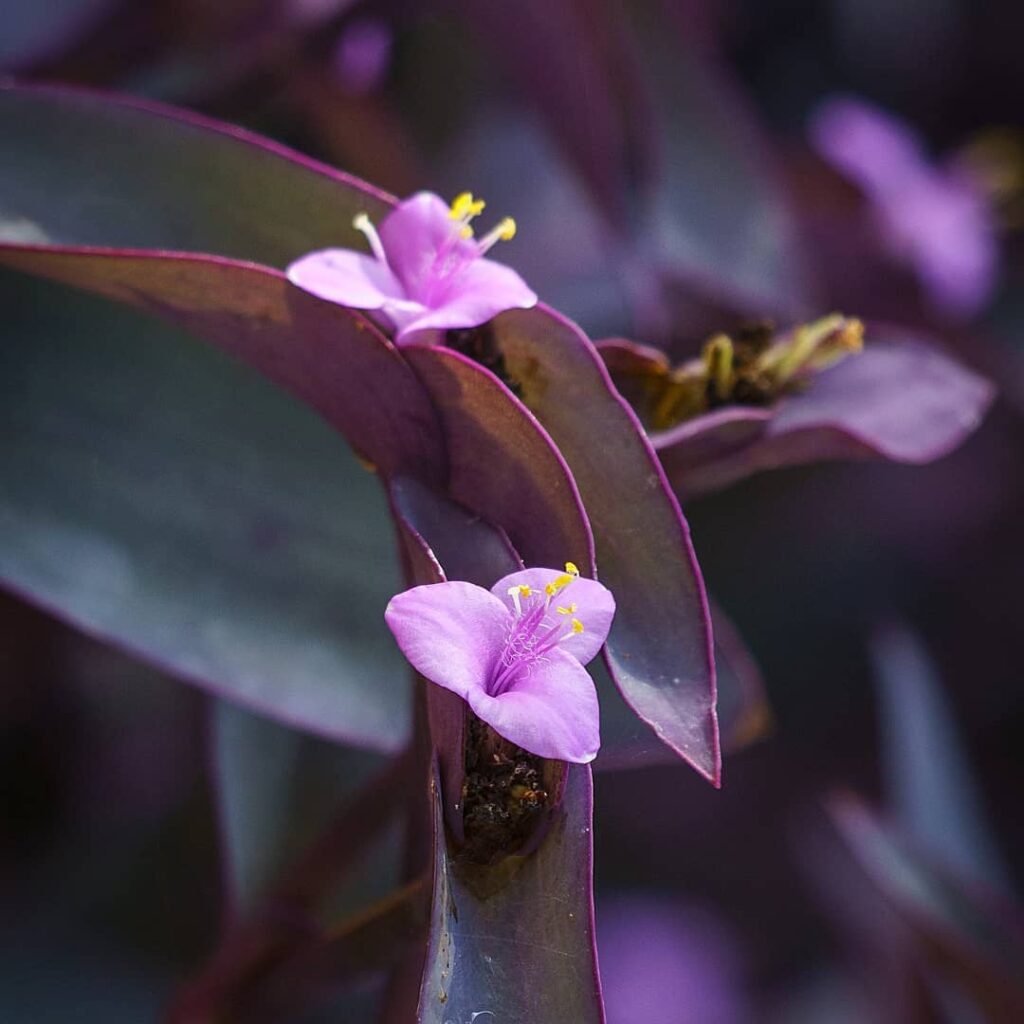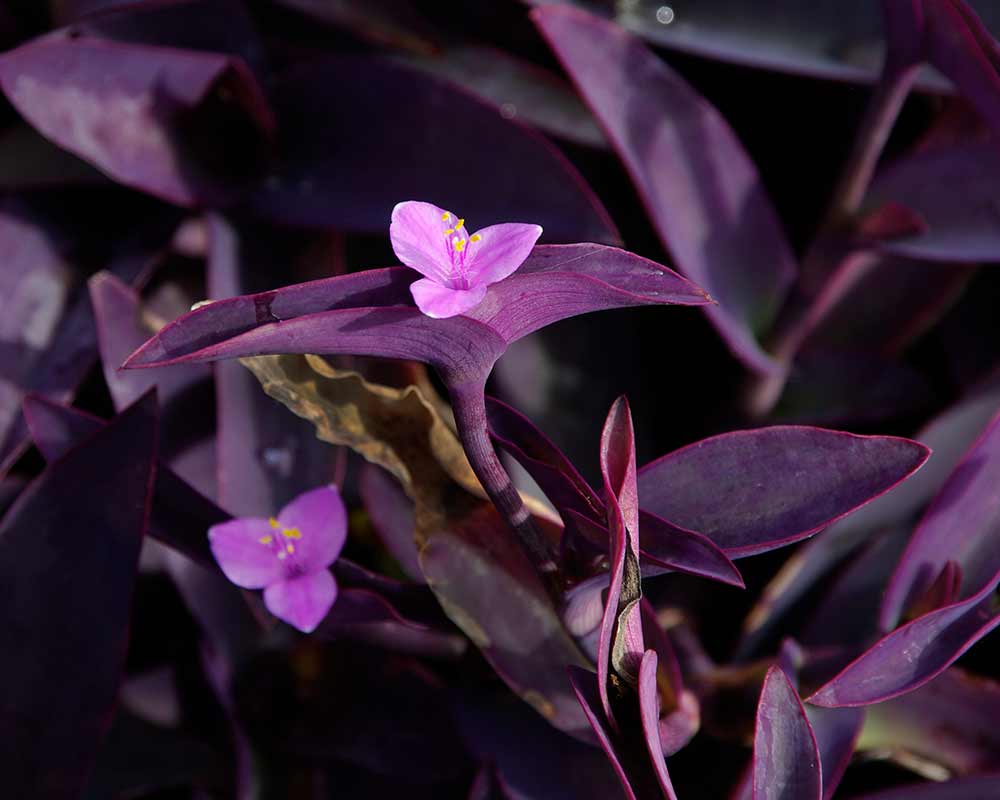This pretty plant is commonly called a “Purple Heart,” although it has a few other names like purple secretia and purple queen. Scientifically it’s called Tradescantia Pallida.
But no matter what you call it, it’s beautiful!
It’s a fast-growing member of the spiderwort family, with rich purple leaves and long purple stems. The plant will bloom small pink and purple flowers, but in contrast to many plants the leaves are often the main reason people like this plant.
One of the reasons we love the Purple Heart plant is because of how versatile it is. You can grow it indoors or outdoors to fit any home design.
Outdoors, it works well as ground cover to add a pop of foliage color and flower color to your yard. We often include it in our landscape designs as a trailing border around rock gardens and other enclosed garden spaces.
Indoors, it can thrive as a container plant in the sunroom, or in a hanging basket near the window.
In this article we’ll introduce some basic care tips that watering, lighting, and pruning. Let’s get started!
How do you care for an indoor Purple Heart plant?
We’ll keep this section short because if we don’t we’ll have to squeeze two articles into one! Indoor care for a Purple Heart plant will long just like outdoor care, but scaled back.
An indoor plant won’t be exposed to as much heat or sunlight so it will grow more slowly and require less water.
How often should you water a Purple Heart plant?
The Purple Heart plant is a fan favorite here in Florida because it does not mind the heat! It’s a surprisingly drought-tolerant plant that doesn’t require a high amount of attention.
Once your plant is all grown up, it will not need any water until the top 1-inch or so of soil is dry. To check, simply use stick a pinky finger in the soil.
Even though Purple Hearts can survive for long periods without being watered, keeping a regular watering schedule is still the best idea.
As a rule of thumb, younger plants will require watering about once a week since they’re still growing. Adults prefer every 10-15 days.
Water your Purple Hearts regularly after repotting them to encourage a well-established root system.
Whether growing the Purple Heart indoors or outdoors as a container plant, choose a pot with drainage holes and use all-purpose potting soil.
How much sun do Purple Hearts need?
In order to maintain their deep purple color, Purple Heart plants need a lot of light – which is usually not a problem if you’re in Florida. The color is simply more vibrant when given plenty of light.
Unlike many of the most beautiful plants, you can absolutely put these flowers in direct sun for most of the day. Of course, having some shade in the afternoon can help prevent them from burning in the case you let their soil get too dried out.
Providing them enough light indoors can be a challenge, even in a sunny window. They’ll do their best with 8+ hours every day. Unless you’ve got a corner of your house that gets morning AND afternoo sun, you might need to set the plant outside every once in awhile.
Although they can tolerate partial shade, they may begin to turn green or become leggy in dimmer settings like a poorly lit window sill.
This isn’t just from personal experience either, we’ve got a Statewide Master Gardener on our side!
“Grow Purple Heart in full sun for best color development; plants growing in shade tend more to green than purple. Pinch the plants to promote more compact growth. Plants are drought tolerant and thrive on neglect, but also tolerate frequent watering. Fertilize monthly when actively growing. Cut plants back after flowering to prevent them from getting spindly. If grown in containers to hold indoors over the winter or as houseplants, reduce watering during the winter and don’t fertilize until new growth starts in spring. Purple Heart has few pests, but scales and mealybugs can be a problem. The juice from the leaves or stems may cause skin redness and irritation in some people and dogs, but this is not a common problem.
Plants are easily propagated by taking cuttings from any part of the plant – just shove a node into the soil or potting mix and it will usually root (or place in water until roots develop). This plant can also be propagated from seed but that is rarely available.”
– Susan Mahr, University of Wisconsin
Do Purple Heart plants come back every year?
Another great advantage to the Purple Heart plant is that it’s an evergreen perennial with a year-round growing season when planted outdoors in USDA hardiness zones 7–11.
Those are Florida’s zones!
The top of the plant will actually die in freezing temperatures like the winters up North. In this situation, the roots will remain alive and the plant will start growing again in early spring.
Bloom time for Purple Hearts planted in warm climates is from the late spring to early fall.
How to pinch Purple Heart plant
Pinch your plant!
Pinching off new stem tips will promote branching and keep your “Purple Queen” compact.
Oh! And don’t toss out those cutting! You can easily propagate them for more plants. If your plant becomes straggly with long gaps between leaves, don’t be afraid to prune stems back to 6 inches in length or shorter.
By pinching the growing tips of your plant, you help create a bushy, compact plant. Then you simply repeat as needed to maintain the desired size and shape.
Where to buy Purple Heart Plants?
Take advantage of these Purple Heart care tips by raising some plants of your own!
Visit our nursery at Troy Tropics and turn your backyard into an outdoor paradise.
Our team of greenery experts can help you decide on the best plants for your home.
Contact us through our online form or call us directly at (941) 212-1671.




